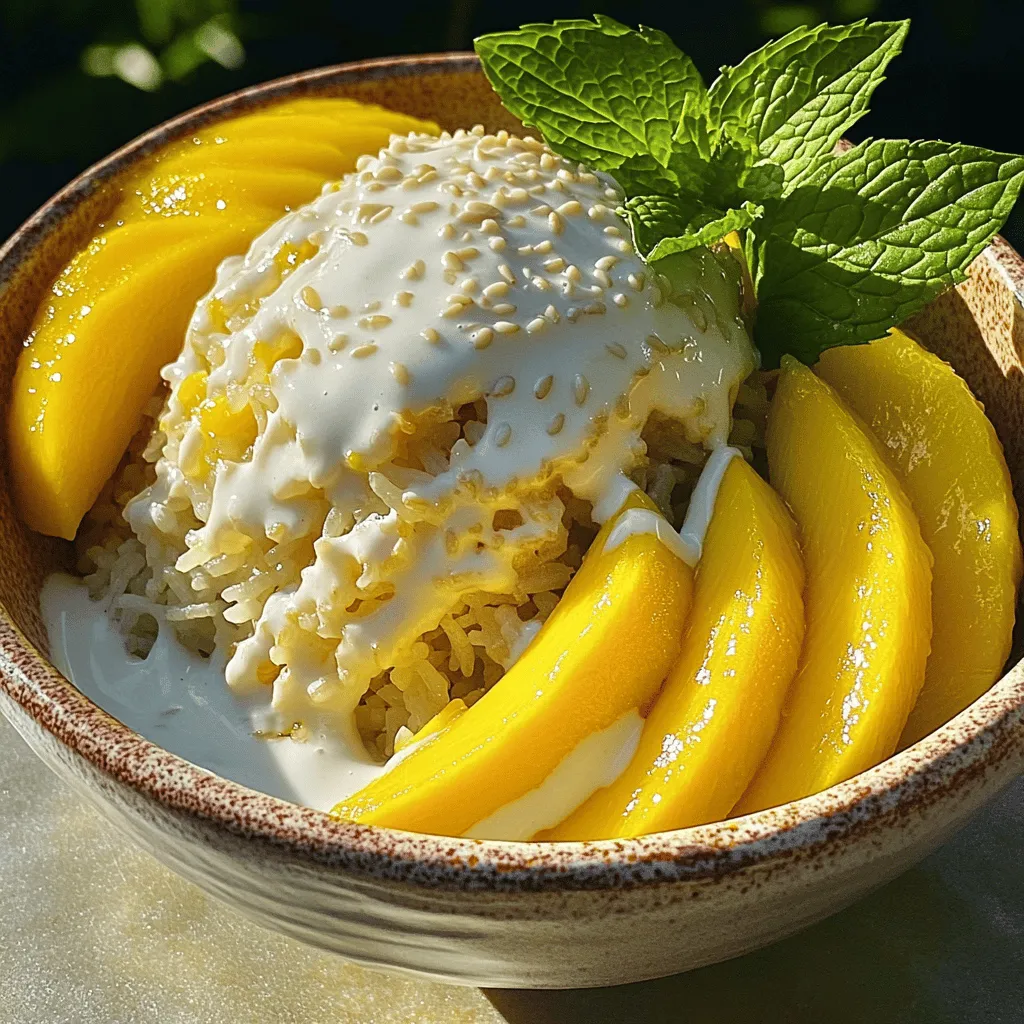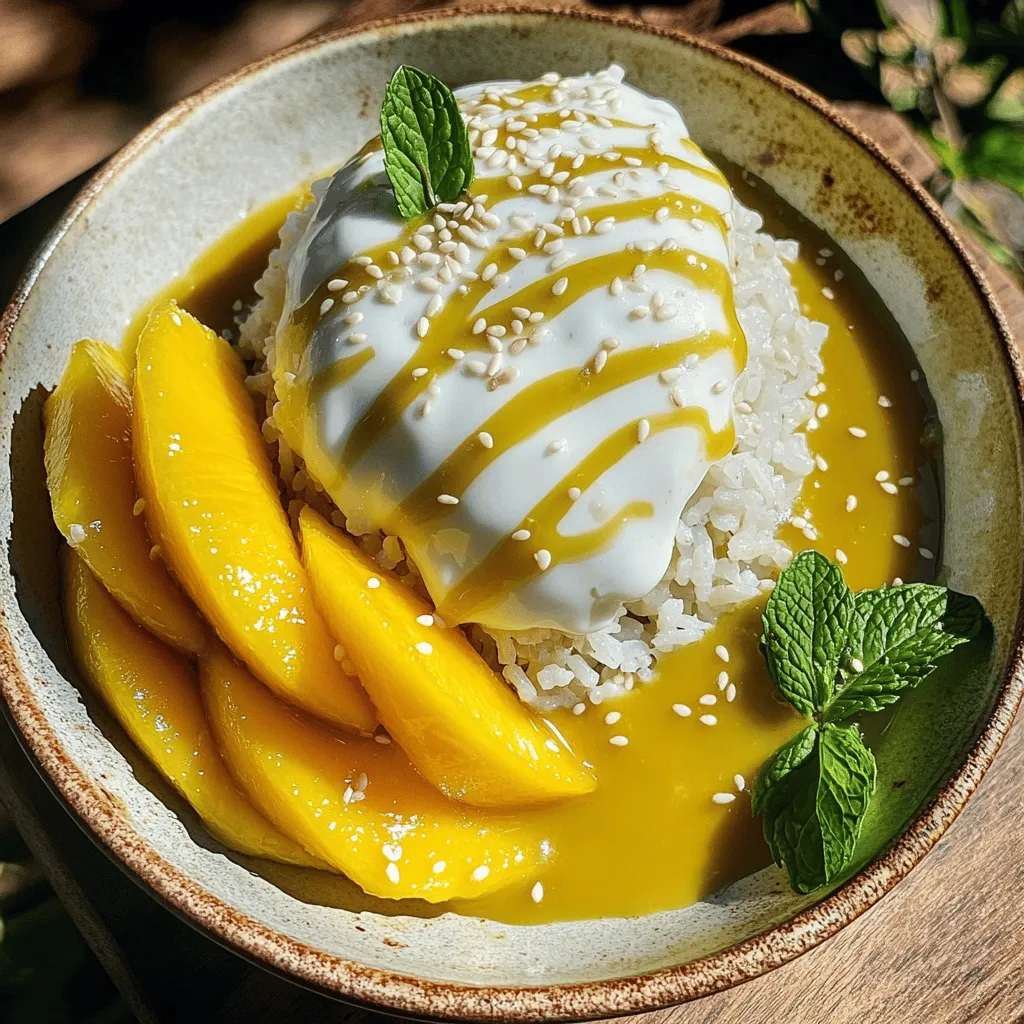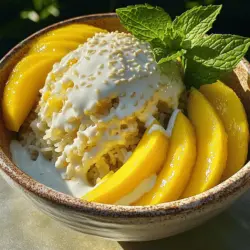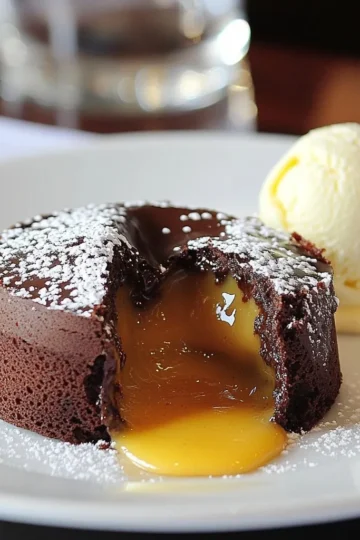Imagine a dish that combines sweet, juicy mango with creamy coconut and sticky rice. That’s Thai Mango Sticky Rice! It’s a simple yet delicious dessert loved by many. In this easy recipe, I’ll share key ingredients, step-by-step instructions, and helpful tips to make your experience fun. Whether you’re a cooking novice or a pro, you’ll impress everyone with this delightful treat. Let’s dive in and savor this Thai classic together!

Ingredients
Essential ingredients for Thai Mango Sticky Rice
To make Thai mango sticky rice, you need a few key items. Here’s what you’ll need:
- 1 cup glutinous (sticky) rice
- 1 ½ cups coconut milk
- ½ cup sugar
- ½ teaspoon salt
- 2 ripe mangoes, peeled and sliced
These ingredients create the base of this sweet and creamy dessert. The sticky rice gives it that unique texture, while the coconut milk adds rich flavor. Fresh mangoes bring a juicy sweetness that perfectly balances the dish.
Optional garnishes for added flavor
While the basic recipe is delicious, you can add some fun garnishes. Here are two great options:
- 1 tablespoon sesame seeds (optional)
- Fresh mint leaves for garnish (optional)
Sesame seeds add a slight crunch, and mint gives a fresh taste. These simple touches can make your dish look even more appealing and flavorful.
Tips for sourcing authentic ingredients
Finding the right ingredients is key to making this dish special. Here are some tips:
- Look for glutinous rice at Asian grocery stores.
- Choose ripe mangoes that feel soft but not mushy.
- Use pure coconut milk for the best flavor.
By sourcing authentic ingredients, you’ll capture the true essence of Thai mango sticky rice. This will help you enjoy a dessert that feels like a treat straight from Thailand.
Step-by-Step Instructions
Preparing the sticky rice
First, rinse the sticky rice. Do this under cold water until the water runs clear. This step helps remove excess starch. You should rinse it about three to four times. After rinsing, soak the rice in water for four to six hours. Soaking overnight gives the best results.
Next, drain the soaked rice. Place the rice in a steamer lined with cheesecloth. Steam the rice for about 30 to 40 minutes. You want it to be fully cooked and tender. Be patient! This step is key to getting the right texture.
Making the coconut sauce
While the rice is steaming, let’s make the coconut sauce. In a saucepan, mix the coconut milk, sugar, and salt. Use medium heat for this. Stir until the sugar dissolves. Do not let it boil. Once done, set aside half a cup of this sauce. You will drizzle it over the dish later.
Assembling and serving the dish
Now that everything is ready, it’s time to assemble. Transfer the cooked sticky rice to a large bowl. Pour the remaining coconut sauce over the hot rice. Gently fold it in, making sure all the rice is coated. Let it sit for 15 to 20 minutes. This waiting time helps the flavors mix well.
To serve, place a scoop of sticky rice on a plate. Arrange fresh mango slices beside the rice. Drizzle the reserved coconut sauce on top. For a special touch, sprinkle sesame seeds and add fresh mint leaves. They add color and freshness to your dish.
Tips & Tricks
Common pitfalls to avoid when making Thai Mango Sticky Rice
When making Thai mango sticky rice, avoid a few common mistakes. First, do not skip rinsing the rice. Rinsing removes extra starch, which can make the rice gummy. Second, don’t rush the soaking time. Soaking for at least four hours helps the rice cook evenly. Lastly, avoid boiling the coconut sauce. Gentle heating is key to keeping the sauce smooth and creamy.
Recommendations for achieving the perfect texture
To get the best texture, use glutinous rice. This rice type is sticky and chewy, perfect for this dish. After soaking, steam the rice in cheesecloth. This keeps the rice from getting too wet. Once cooked, let it sit for a bit after mixing in the coconut sauce. This allows the rice to absorb flavors and achieve a soft, fluffy texture.
Suggestions for enhancing flavor profiles
To boost flavors, try adding more coconut milk to the sauce. A richer sauce pairs well with the sweet mango. You can also sprinkle sesame seeds for a nutty crunch. If you want a fresh touch, add mint leaves as a garnish. This adds color and a bright taste. For a twist, consider adding a pinch of lime zest to the coconut sauce for a citrus kick.

Variations
Alternative ingredients for dietary preferences
If you want to change things up, you can swap ingredients. Here are some ideas:
- Rice Substitutes: Try using quinoa or brown rice for a healthier twist.
- Sweeteners: Use honey or maple syrup instead of sugar for a natural taste.
- Coconut Milk Choices: If you need a dairy-free option, use almond or oat milk.
These swaps can still give you a tasty Thai mango sticky rice.
Creative serving ideas beyond traditional presentation
Serving this dish can be fun! Here are some creative ideas:
- Mango Cups: Use hollowed-out mango halves as bowls. Fill them with sticky rice for a fun look.
- Layered Parfaits: Layer sticky rice and mango slices in glasses. Top with coconut sauce for a colorful dessert.
- Dessert Sushi: Roll sticky rice and mango in thin rice paper. Slice them like sushi for a fun twist.
These ideas can make your dish stand out at any gathering.
Regional variations of Thai Mango Sticky Rice
Thai mango sticky rice varies across regions in Thailand. Some variations include:
- Northern Thailand: This version may add black sesame seeds for a unique taste.
- Southern Thailand: You might find them adding a pinch of pandan for extra flavor and color.
- Street Style: Street vendors often serve it warm with a sprinkle of crispy mung beans for crunch.
Exploring these regional differences can give you a richer experience of this beloved dessert.
Storage Info
Best practices for storing leftover sticky rice
To store leftover sticky rice, place it in an airtight container. This keeps moisture in and prevents it from drying out. You can also wrap it in plastic wrap. Make sure it cools to room temperature first. Do not store warm rice, as it can cause bacteria to grow.
Tips for reheating while maintaining texture
When you reheat sticky rice, the goal is to keep it soft and sticky. The best method is steaming. Place the rice in a steamer basket lined with cheesecloth. Steam for about 10 minutes. You can also use the microwave. Add a few tablespoons of water to the rice and cover it with a damp paper towel. Heat in short bursts, stirring in between, until warm.
How long does homemade Thai Mango Sticky Rice last?
Homemade Thai Mango Sticky Rice can last up to three days in the fridge. Make sure it is in an airtight container. If you want to keep it longer, you can freeze it. Wrap the sticky rice tightly in plastic wrap and then in foil. It can last for about a month in the freezer. When you’re ready to eat it, thaw it in the fridge overnight before reheating.
FAQs
Can I use regular rice instead of glutinous rice?
No, you cannot use regular rice. Glutinous rice gives this dish its sticky texture. It absorbs the coconut milk well, making it creamy and delicious. Regular rice will not provide the same results. If you want the authentic taste, stick to glutinous rice.
How can I make this recipe dairy-free?
To make this recipe dairy-free, use coconut milk. It is already dairy-free and provides rich flavor. Just ensure that the brand you choose does not add any dairy. You can also skip the optional sesame seeds if they contain any dairy products.
What is the cultural significance of Thai Mango Sticky Rice?
Thai Mango Sticky Rice is a beloved dessert in Thailand. It celebrates the mango season, which is from April to June. This dish symbolizes sweetness and joy. It is often served during festivals and special occasions. Enjoying this dessert connects you to Thai culture and traditions.
Thai Mango Sticky Rice is easy to make when you know the steps. We talked about essential ingredients, tips for sourcing, and added garnishes. Preparing it involves making the sticky rice and coconut sauce, and then serving it all together. I shared ways to avoid common mistakes and enhance the dish’s flavor. You can even try different variations to suit your tastes.
In the end, enjoy this classic dessert and share it with friends. It’s a delightful treat that brings joy to every meal. Happy cooking!






Leave a Reply